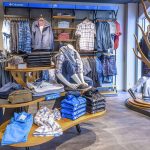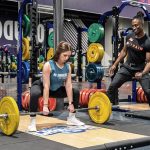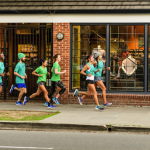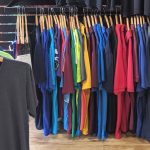The Finish Line Inc. posted a profit of $2.3 million, or 5 cents a share, in its fiscal third quarter ended Nov. 30, rebounding from a net loss of $103,000, or less than one cent a share, a year ago. With results particularly aided by a 7.1 percent comp gain, EPS ran 5 cents ahead of Wall Street's consensus estimate.
The strong performance prompted management to lift its guidance for the full year.
Net sales in the quarter grew 22.9 percent to $364.5 million. The increase was made up of Finish Line banner sales that were up 9.7 percent; sales associated with its new Macy's partnership of $33.5 million; and Running Company sales that contributed $13.9 million versus prior year of $7.6 million, FINL officials said on a conference call with analysts.
The 7.1 percent company-wide comp gain came on top of a 3.6 percent increase in the year-ago period. For stores, comp sales advanced 6.8 percent, on top of a 0.6 percent increase in Q3 last year. Digital comp sales expanded 8.4 percent for the quarter and represented 13.8 percent of total sales. By month, comps were up 5 percent in September, jumped 12.7 percent in October, and grew 4.9 percent in November. December comps to-date were up in the mid-single-digits.
Footwear comps were up 8.9 percent while soft goods comp decreased 1.2 percent. Footwear ASPs increased 1 percent.
On the call, Sam Sato, president, Finish Line Brand, said just as predicted during its fiscal second quarter earnings call, running trends improved in the fiscal third quarter, basketball remained strong, and softgoods showed positive progress. He noted the improvement came despite “what has been a choppy macro environment.”
On the footwear side, men's comps were up the high-singles, women's increased in the mid-singles and kids' jumped up in the low-double-digits.
“Importantly, this was the best women's performance in some time, while kids' remained a consistent strength for us,” said Sato. “In fact, our kids' business has posted a low-teen average annual increase over the past three years and trends don't appear to be slowing.”
Running comps returned to positive territory in the quarter, up in the mid-single-digits, fueled by strong performance across-the-board from Nike, led by continued “nice gains” from the Free, Air Max, and Shox. Nike Flyknit sales accelerated during the quarter, and both Springblade by Adidas and its exclusive Under Armour Spine Lazer “did extremely well.”
Asics and Brooks were both up in double-digits on a comp basis, underscoring the ongoing popularity of their fashion technical styles. Particularly encouraging was the high-single-digit gain in women's running, “a meaningful trend change driven by demand for Nike, Asics, and Brooks,” said Sato.
Basketball comps were up high-teens, benefiting from particular strong demand for both Nike and Jordan products. Within Nike signature products, both LeBron and KD “performed extremely well” and the Jordan brand “once again delivered incredible results” across categories. The Adidas D Rose shoe launch performed well and “”have remained robust despite his season-ending injury.”
Soft goods saw sequential improvement quarter over quarter with comps down just slightly. The improvement was most evident in youth, licensed, and branded apparel, which included “very strong gains” from Nike, Jordan, and Under Armour. Premium branded socks, bags, along with shoe care, also positively impacted results.
Comps over Black Friday weekend jumped in the low 20 percent range over the same Thursday-to-Sunday period one year ago. Store sales started off strong, due in part to having them open earlier on Thanksgiving Day, and “remained robust” into the weekend
The gains were aided by a recent e-mail to its Winners Circle members announcing a new product launch. Within the first seven days of receiving the e-mail, 87 percent of the transactions took place in-store. Its Winner Circle members accounted for 62 percent of transactions in the quarter, up from 33 percent just three years ago.
Gross margins decreased 70 basis points from a year ago to 29.6 percent. Product margin net of shrink was down 100 basis points due to higher markdowns due to aggressive inventory management. For Finish Line, inventory was up less than 1 percent at the quarter’s end.
Consolidated SG&A expense was 28.6 percent of sales, which decreased 220 basis points, benefiting from expense leverage.
On the call, Glenn Lyon, The Finish Line’s chairman and CEO, said he saw the strong results as a direct result of the investments the company has made developing its omni-channel platform.
“I witnessed firsthand the impact of our efforts over the Black Friday weekend, as technology utilized by our store associates helped drive an improved customer experience and increased conversions,” said Lyons. “On Black Friday alone, we processed approximately 70,000 transactions through handheld devices, dramatically speeding up the checkout process during peak selling periods.”
At the same time, Web orders were being fulfilled from the back of stores. Overall Web deliveries are becoming quicker as Finish Line can better handle multiple unit orders.
Also helping the omni-channel push is creating more personalized consumer engagements online that are supporting brick & mortar sales. For example, 25 percent of visitors to FinishLine.com are researching product to buy off-line. This has led to a spike in store locator mobile traffic, especially on weekends. Among its Winners Circle members, 87 percent are more likely to go in-store to purchase after receiving an email than they are to purchase online. Added Lyon, “Clearly the customer is utilizing technology to become better informed prior to purchase, with online research ultimately leading to increased store traffic as well.”
Regarding its initiative with Macy’s, Lyon said there are currently 181 Finish Line shops in Macys’ and management is “pleased with the overall results” while continuing to refine the approach. The partnership is particularly helping Finish Line’s team understand the female consumer better, which shops less in Finish Line’s core stores. Said Sato, “We have learned that product innovation and fashion is important and will continue to evolve our offer to satisfy her needs. The great thing is we have been able to reap these benefits of the Macy's partnership with no cannibalization to our Finish Line store and digital business.”
Running Specialty Group closed on the acquisition of Running Spot, a four-store chain with locations in Ohio and Kentucky, during the quarter. Following on past acquisitions of other acclaimed running shops like Boulder Running and Run On!, “we are strengthening the reputation we have established in specialty running,” said Lyon. It had 47 stores in place at quarter’s end, adding 20 net stores in the year and still planning to add 30 for the year through openings and acquisitions.
Smooth integrations are encouraging a “willingness of other small chains to engage in discussions” about potential acquisitions. Critical has been retaining the founders to continue each chain’s strong emphasis on community and local presence. Said Lyon, “As we build this growth platform and learn more about the specialty running customer, we are lifting and shifting the community programs and customer service standards of successful local operators as we share best practices across the chain to drive increased productivity.”
Based on its third quarter and December month-to-date results, FINL now projects comparable sales for its current fiscal year to increase 3 percent to 4 percent, up slightly from its previous expectation for a low-single-digit increase. EPS is expected to increase 9 percent to 12 percent, to $1.60 to $1.65, from last year's adjusted EPS of $1.47. That compares to its previous expectation for a mid-single-digit increase.















